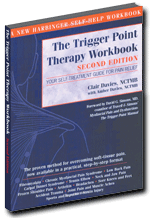|
|
The Trigger Point Therapy Workbook: Your Self-Treatment Guide for Pain Relief, 2nd Edition
Book Review by Steven Lavitan, DC, Lac
|
Title:
|
The Trigger Point Therapy Workbook: Your Self-Treatment Guide for Pain Relief, 2nd Edition
|
|
Author/editor:
|
Clair Davies, NCTMB
|
|
Publisher:
|
New Harbinger Publications
|
|
Part #:
|
T-285
|
 For those of us who don't recognize many health care abbreviations beyond DC, NCTMB means Nationally Certified in Therapeutic Massage and Bodywork. But to call The Trigger Point Therapy Workbook a discussion of massage would be akin to referring to a Monet as graffiti. For those of us who don't recognize many health care abbreviations beyond DC, NCTMB means Nationally Certified in Therapeutic Massage and Bodywork. But to call The Trigger Point Therapy Workbook a discussion of massage would be akin to referring to a Monet as graffiti.
Trigger-point therapy is not new, but Janet Travell, MD, who happened to be JFK and LBJ's White House physician, popularized it among the medical people. She was over 90 when she released the second volume of her magnum opus and close to 100 when she died. David Simons, MD, was her coauthor, aerospace physician and the former holder of the altitude record in a balloon, as well as a researcher of some note.
Together, Travell and Simons wrote the equivalent of Gray's Anatomy of trigger points. Unfortunately, it takes a huge investment to get much from the original work. It cost over $100 and is a most technical and difficult read. It took this reviewer over six months to read both volumes from cover to cover and I still refer to it constantly. Only my medical dictionary gets more use.
So, what is the average chiropractor to do if they want to know trigger points (TPs) but don't have the time or inclination to study Travell and Simons directly? Reading and studying The Trigger Point Therapy Workbook, by Clair Davies, which costs $19.95 and can be read in less than a week and then kept as a quick study reference, is good way to go. There are other options out there, but Davies' work provides a quicker and cheaper introduction. There is one caveat though: The material is meant to be self-administered, but in the penultimate chapter, treatment to others is addressed.
In the chiropractic community, many of us had the pleasure of studying with Dr. Raymond Nimmo. He was this little guy from Texas with a friendly drawl, a 10-gallon hat and a knack for finding and breaking up trigger points that would just make you want to cry. Dr. Nimmo has passed on and much of his work is no longer in vogue. Dr. Cyriax, the British physician, did some brilliant work that was picked up and expanded by Dr. Warren Hammer in his treatise on soft-tissue work. Recently, Dr. Michael Leahy developed a form of dynamic palpation of muscle that is effective in stretching chronically contracted muscles, freeing traction neurodesis (a nerve that has been entrapped in muscle or other soft tissue), or just plain releasing stuck trigger points. All these other approaches require a much larger investment in time and money to get started. The Trigger Point Therapy Workbook is a tremendous bargain.
This book is a great introduction and gives the practitioner a solid place to begin examining TPs. There are interesting correlations symptomatically: dyspareunia or pain after intercourse with the abductor magnus; pseudo-anginal pain with the scalene muscles; a persistent, dry cough or pain in the top, front or sides of the head with the sternal division of the SCM (sternocleidomastoid); and dizziness, prone to lurching or falling unexpectedly, and even reversible hearing loss, with the clavicular division of the SCM.
Davies also uses the original Travell and Simons algorithm of working backward from painful areas to the list of offending muscles. Then each muscle has the likely TPs mapped out which are confirmed by palpation. Finally, if the TPs are obliterated by needling or rubbing out, there should be symptomatic improvement.
In this second edition, there are two new chapters. The first is by Amber Davies, Clair's daughter, and in it there are illustrations and text describing massage techniques for alleviating trigger points in others. The second new chapter gets into some of the socio-psycho-physiological aspects of muscle tension. It includes some family dynamics, systemic desensitization, a subtle form of contract relax, passive flooding (giving yourself permission to be tense so you have awareness without resistance) and finally, paradoxical intention, a technique in which one confronts their fears.*
In the 323-plus pages (plus a great index), you can start using one of the most powerful, well-documented approaches in all of physical medicine. This book rates a 10 as an introduction to trigger-point work. The only practitioners this book is not recommended for are those who already have and use Travell and Simons' trigger-point manual. Good luck and happy hunting for those pesky trigger points!
*(For more on these techniques, you might read the work of Dr. Sarno, a physiatrist from NYU, or the writing of two psychiatrists, Drs. Viktor Frankl and Edmund Jacobson.)
To order a copy of this book, call (800) 359-2289 or visit www.ChiroMall.com.
If you have authored, published or produced a book or an audio, video or software product that is chiropractic-oriented, educational, nonpromotional and written or produced in a professional manner, and would like it reviewed in Dynamic Chiropractic, please send two copies of the book or product to:
Review Editor
Dynamic Chiropractic
P.O. Box 4109
Huntington Beach, CA 92605
Items submitted for review will not be returned.
Dr. Lavitan's Rating:
 10
out of
10
10
out of
10
|

|








